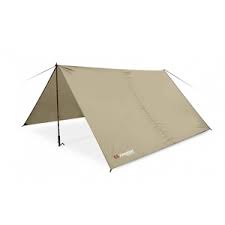Camping equipment

Tourist-canoeist, to be free and independent, must have appropriate camping equipment.
Use of hostels and casual quarters, as well as camping centers does not always give us satisfaction, the more that we are dependent on the stopping place. So we try to have our own tent, possibly replacement tent sheets. Buying a tent is always associated with some difficulties. Firstly, it is a serious expense, Secondly, the number of types produced causes a dilemma as to the choice. We have to remember, that the tourist-canoe's tent should be light, waterproof, comfortable, extensive, easy to set up and pack, and with a gummed floor.
The most common tent in canoeing trips is the cottage type tent. This tent has a sewn-in floor, it is easy to set up, weighs approx 8 kg. It is produced by Zakłady w Legionowo as the "Tourist 2″ with dimensions of 2.55X1.25X1.20, made of impregnated fabric in various colors.
In the equipment of the above-mentioned tent we find: set of frames, tracks, links, cover and bag for herring.
The "Tourist 3″ about dim. 2,70X1.80X1.80, weight 7,40 kg, with an apse for luggage at the rear wall.
The prices of the tents most useful for a canoeing tourist range from 1100 do 2800 PLN.
A tourist cannot always afford such an expense, especially if completing the equipment starts from scratch. If he decides to make a tent on his own - following the example of factory tents - then its cost will be PLN 500-600.
If we do not have any tent or cash to buy one, we protect ourselves from unpleasant weather conditions, the so-called. tent sheets. Such a cloth, which does not require a lot of work and money, can be made of tent fabric, as well as from an old tarpaulin or worn-out waterproof material.
Flysheet tent or tent sheets, to extend their "life , we must maintain and, as far as possible, protect from improper use, remembering, that you should:
1. Protect them from tearing or perforation. If we already have a fault, this should be fixed with a patch with even edges, cut from the same material (impregnated), on the outer side sewing with a double stitch. If there is an abrasion, we patch from the inside.
2. Protect against excessive sunlight.
3. Extractors (links) should be at ease.
4. Before packing, the tent and flysheet should be dry, and the rubberized floor is slightly lacquered.
5. Before folding the tent for the winter period, the flysheet or cloth should be thoroughly dried, aired and reviewed. The same goes for lines and tracks.
The above-mentioned equipment is secured as follows:
a) tent, flysheet or a repaired tent sheet, clean, supplemented by replacing damaged loops, buttons, zippers, latches, etc.. fold loosely and, if possible, ventilate a few times during the winter;
b) if the tent material, tropic, the sheet is dirty with stains, we lure them with the "Tri” or put it in dry cleaning;
c) Grease the lines-straps slightly and roll them up tightly after drying;
d) complete the pegs, we clean, if they are wooden, rub it with varnish, if metal - with petroleum jelly or oil;
e) masts - proceed as in point. d) tj. Wood parts will be varnished, grease the metal ones slightly.
An indispensable part of our equipment is a rubber mattress, and a sleeping bag. Down sleeping bags are available on the market, of cotton wool, woolen and synthetic materials. We can make such a sleeping bag ourselves, from old materials, following the example of the factory. We clean the sleeping bag during the season, we shake, shaken off after the season, clean and dry, place loosely in an anti-moth bag.
The airbag is maintained like a mattress, must be protected against abrasion or puncture. In the event of damage, we immediately remove the defect by cleaning and sticking the patch with rubber glue.